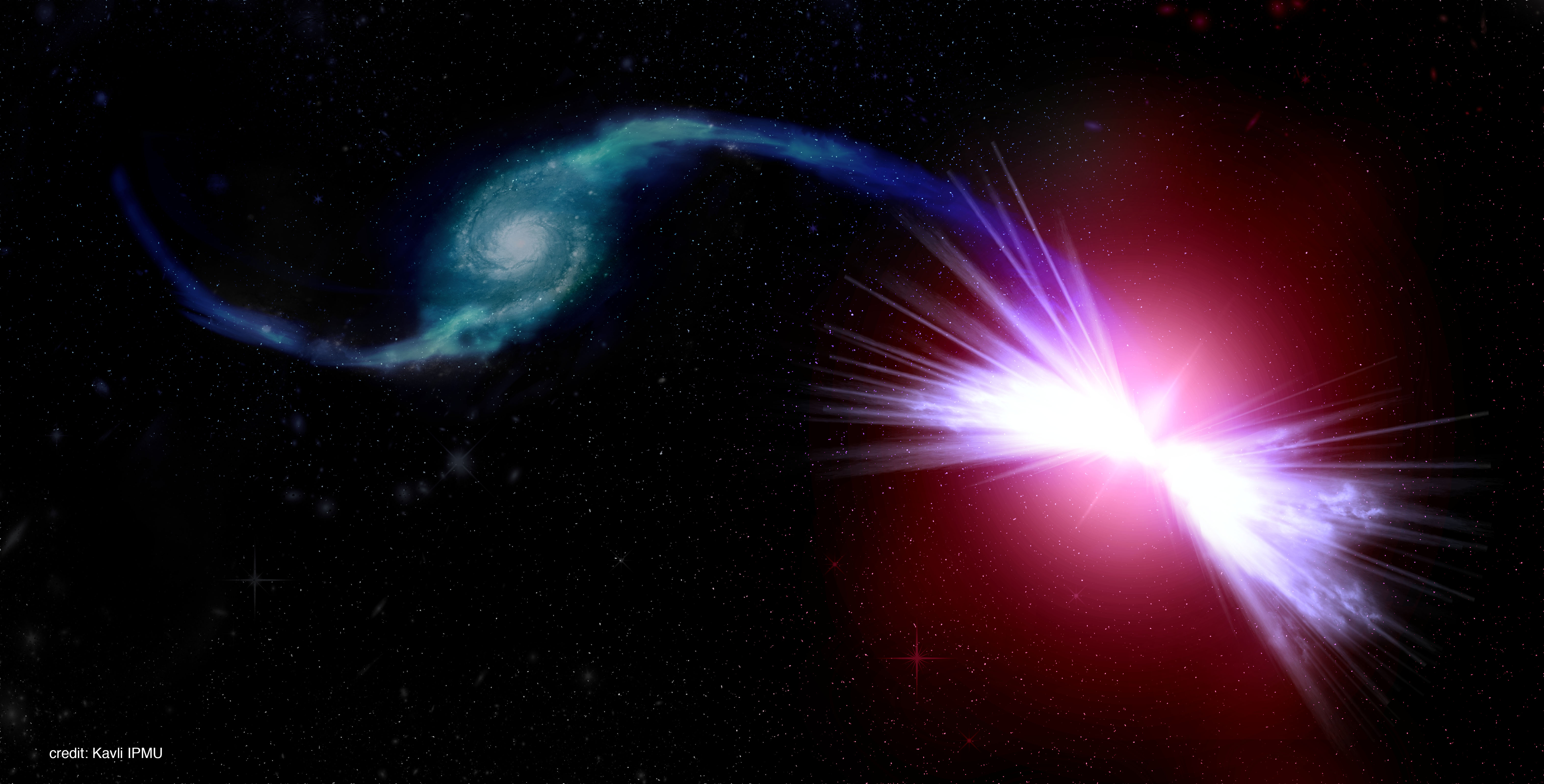An artist’s rendition of the galaxies Akira (right) and Tetsuo (left) in action.
Akira’s gravity pulls Tetsuo’s gas into its central supermassive black hole, fueling winds that have the power to heat Akira’s gas. The action of the black hole winds prevents a new cycle of star formation in Akira.
Image Credit: Kavli IPMU
For most of their lives, galaxies are lush environments for turning gas into stars. Until they aren’t.
Over the last few billion years, a mysterious kind of “galactic warming” has turned huge numbers of galaxies into deserts devoid of fresh young stars. The puzzle for astronomers has been identifying the unknown process that keeps the gas in these dormant galaxies too hot and energetic to form stars.
Today, astronomers from the Sloan Digital Sky Survey (SDSS) are announcing the discovery of a new class of galaxies called “red geysers” that harbor supermassive black holes with winds that have the power to keep dormant galaxies quiet.
“We knew that there had to be a way to prevent star formation in these galaxies, and now we have a good idea of what it is,” says Edmond Cheung, the lead author of the study published today in the journal Nature. Cheung, an astronomer at the University of Tokyo’s Kavli Institute for the Physics and Mathematics of the Universe, was working with an international team of astronomers studying hundreds of galaxies when they caught a supermassive black hole blasting away at the cold gas in its host galaxy.
Edmond Cheung
“We knew that there had to be a way to prevent star formation in these galaxies, and now we have a good idea of what it is.”
“Galaxies start out as star-making machines with a simple recipe: gas plus gravity equals stars,” says Kevin Bundy, co-author on the study and Principal Investigator of the new SDSS campaign that led to the discovery. “Here we have a galaxy that has everything it needs to form new stars, but is dormant. Why is that?”
Astronomers had long suspected that the reason had something to do with the supermassive black hole found at the centers of many galaxies, but solid evidence was lacking. One reason was that it used to be difficult to map the internal structure and motions of gas and stars throughout a galaxy. “If we looked just at the center of the galaxy like we used to, we could have learned about the central black hole, but we would have missed the story of how it affects the rest of the galaxy,” Cheung says. “Another reason is that the wind from supermassive black holes comes and goes quickly, so catching the wind red-handed is hard.”
The secret to capturing the whole story is the SDSS’s new component survey, Mapping Nearby Galaxies at Apache Point Observatory (MaNGA). “With MaNGA’s technological upgrade to the Sloan Foundation Telescope, we can make detailed maps of galaxies ten to a hundred times faster than we could just ten years ago,” says Renbin Yan of the University of Kentucky, a co-author of the study and MaNGA’s Survey Scientist. “Since MaNGA studies so many galaxies, our snapshots can reveal even the quickest changes happening in galaxies. And that’s how we found Akira.”
Renbin Yan
“Since MaNGA studies so many galaxies, our snapshots can reveal even the quickest changes happening in galaxies.”
Cheung nicknamed this premier example of a red geyser galaxy “Akira” after the famous Japanese manga comic character, an homage to both the MaNGA survey and his home institution in Japan. Akira has a companion galaxy that Cheung called “Tetsuo” for another character in the same manga. Akira is pulling gas away from Tetsuo, which fuels Akira’s supermassive black hole winds. The winds driven by Tetsuo’s gas are the reason that Akira is currently a red geyser galaxy. Bundy came up with the name “red geyser” because these wind outbursts reminded him of the sporadic eruptions of a geyser and because the failure to form new stars leaves the galaxy with only red stars.
As with global warming on Earth, galactic warming has long-term consequences for red geyser galaxies – their gas can no longer form new stars. “You can think of these winds as super-heating the atmospheres of galaxies,” Cheung says. “As soon as any gas starts to cool, it gets blasted by this wind, like water droplets turning to steam.” The team theorizes that this phenomenon is quite common in dormant galaxies. Therefore, our own Milky Way Galaxy may not be safe from this galactic warming – distant future generations may see our supermassive black hole turning our galaxy into a red geyser.
Images
An artist’s rendition of the galaxies Akira (right) and Tetsuo (left) in action.
Akira’s gravity pulls Tetsuo’s gas into its central supermassive black hole, fueling winds that have the power to heat Akira’s gas. The action of the black hole winds prevents a new cycle of star formation in Akira.
Image Credit: Kavli IPMU
Contacts
- Edmond Cheung, Kavli Institute for the Physics and Mathematics of the Universe (Kavli IPMU), ec2250@gmail.com, +81 04 7136 6553
- Kevin Bundy, Kavli Institute for the Physics and Mathematics of the Universe (Kavli IPMU), kevin.bundy@ipmu.jp, +81 (0)4 7136 6513
- Renbin Yan, University of Kentucky, yanrenbin@uky.edu, +1 859-257-0795
- Michele Cappellari, University of Oxford, michele.cappellari@physics.ox.ac.uk, +44 1865 273 647
- Jordan Raddick, SDSS Public Information Officer, Johns Hopkins University, raddick@jhu.edu, 1-443-570-7105
About the Sloan Digital Sky Survey
Funding for the Sloan Digital Sky Survey IV has been provided by the Alfred P. Sloan Foundation, the U.S. Department of Energy Office of Science, and the Participating Institutions. SDSS- IV acknowledges support and resources from the Center for High-Performance Computing at the University of Utah. The SDSS web site is www.sdss.org.
SDSS-IV is managed by the Astrophysical Research Consortium for the Participating Institutions of the SDSS Collaboration including the Brazilian Participation Group, the Carnegie Institution for Science, Carnegie Mellon University, the Chilean Participation Group, the French Participation Group, Harvard-Smithsonian Center for Astrophysics, Instituto de Astrofísica de Canarias, The Johns Hopkins University, Kavli Institute for the Physics and Mathematics of the Universe (IPMU) / University of Tokyo, Lawrence Berkeley National Laboratory, Leibniz Institut für Astrophysik Potsdam (AIP), Max-Planck-Institut für Astronomie (MPIA Heidelberg), Max-Planck-Institut für Astrophysik (MPA Garching), Max-Planck-Institut für Extraterrestrische Physik (MPE), National Astronomical Observatory of China, New Mexico State University, New York University, University of Notre Dame, Observatório Nacional / MCTI, The Ohio State University, Pennsylvania State University, Shanghai Astronomical Observatory, United Kingdom Participation Group, Universidad Nacional Autónoma de México, University of Arizona, University of Colorado Boulder, University of Oxford, University of Portsmouth, University of Utah, University of Virginia, University of Washington, University of Wisconsin, Vanderbilt University, and Yale University.




